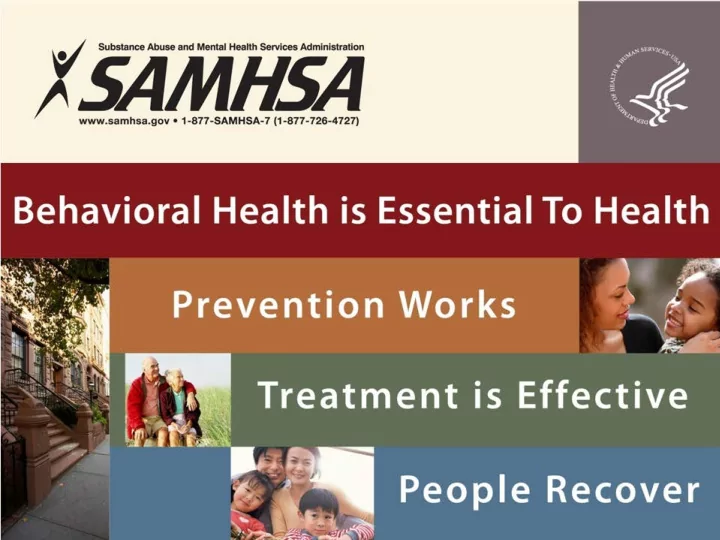

2 Health Insurance Enrollment: Assisting Individuals with Behavioral Health Conditions 2
Content 3 Overview of the prevalence of behavioral health (bh) conditions in U.S. adults Health Insurance Considerations: Questions to Ask Tips for Assisters Resources
PREVALENCE OF BH CONDITIONS AMONG UNINSURED MEDICAID-ELIGIBLE ADULTS AGES 18-34 WITH INCOMES <139% FPL 5 42.0% SMI/ 58.0% SPD/ SUD “Behavioral Health Conditions” include serious mental illness (SMI), serious psychological distress (SPD) and substance abuse disorders (SUD) Source: National and State Estimates of the Prevalence of Behavioral Health Conditions Among the Uninsured, 2013, http://store.samhsa.gov/product/National-and-State-Estimates-of-the-Prevalence-of-Behavioral-Health-Conditions-Among- the-Uninsured/PEP13-BHPREV-ACA
PREVALENCE OF BH CONDITIONS AMONG UNINSURED ADULTS AGES 18-34 WITH INCOMES 139-400% FPL 6 44.0% SMI/ 56.0% SPD/ SUD “Behavioral Health Conditions” include serious mental illness (SMI), serious psychological distress (SPD) and substance abuse disorders (SUD) Source: National and State Estimates of the Prevalence of Behavioral Health Conditions Among the Uninsured, 2013, http://store.samhsa.gov/product/National-and-State-Estimates-of-the-Prevalence-of-Behavioral-Health-Conditions-Among- the-Uninsured/PEP13-BHPREV-ACA
PREVALENCE OF BH CONDITIONS AMONG UNINSURED ADULTS AGES 35 AND OVER WITH INCOMES <400% FPL 7 23.8%SMI/ SPD/ SUD 76.2% “Behavioral Health Conditions” include serious mental illness (SMI), serious psychological distress (SPD) and substance abuse disorders (SUD) Source: National and State Estimates of the Prevalence of Behavioral Health Conditions Among the Uninsured, 2013, http://store.samhsa.gov/product/National-and-State-Estimates-of-the-Prevalence-of-Behavioral-Health-Conditions-Among- the-Uninsured/PEP13-BHPREV-ACA
Important Considerations in Working with Individuals with BH Conditions 8 The previous slides illustrate the high prevalence of substance abuse and mental health conditions among the uninsured As a result of the Affordable Care Act and the Mental Health Parity Act, many behavioral health treatments, as well as preventative screenings, are part of insurance coverage through the Marketplace • For example: – Behavioral health services are essential health benefits – No denial for pre-existing conditions – No lifetime or yearly dollar limits for mental health services – Parity protections for behavioral health services
Health Insurance Considerations: Questions to Ask People You Serve 9 1) Discuss the individual’s provider network • Ask the individual if they have particular providers that they, or a member of their family, currently see and would like to continue seeing – Use this information to determine a) what networks include their preferred providers and b) what plans would be best for the individual – If providing assistance in person, you may consider providing the person with hardcopies of network information – If providing assistance over the phone, you many consider explaining how the person can find information about networks online
Health Insurance Considerations: Questions to Ask People You Serve 10 2) Discuss the individual’s wellness plan, particularly prescription medications • Ask the individual if there are certain prescription medications that they, or their family, may require or anticipate needing – Help the individual determine a) what types of plans cover certain medications and b) how to understand a prescription formulary – If providing assistance in person, you may consider providing the individual with information about plans that cover a variety medications and wellness needs – If providing assistance over the phone, you many consider explaining how the person can find information about prescription plan coverage online
Health Insurance Considerations: Questions to Ask People You Serve 11 3) Discuss other services that the individual requires or may anticipate requiring • Ask the individual if there are any other medical or non- medical services that they currently use or anticipate using – For example: • Inpatient care • ER visits • Therapy services (occupational, physical, educational) • Substance use treatment • Screenings • Other covered services
Tips for Assisters 12 Engage all people as people first and not as a diagnosis Health care and health insurance can be a complex issue for many people, not just those with a behavioral health condition Keep information simple and clear Engage people in a trusting relationship • Use active listening skills. For example, repeat back in the person words “what I hear you saying…” in order to check for understanding. • Take time to understand the person’s style of interaction and communication • Ask the person directly what would help them while working with an assister Have patience and be willing to spend extra time • If a person is struggling or having a difficult time, ask them what they need. Suggest taking a break or offering to set another appointment.
Tips for Assisters 13 Familiarize yourself with local, regional and national organizations • For example: – The National Alliance on Mental Illness (NAMI) is the nation’s largest grassroots mental health organization with 1000 affiliates across the country. Connect individuals you serve with consumer oriented organizations to help empower knowledge and choice • For example: – The National Mental Health Consumers’ Self-Help Clearinghouse, http://www.mhselfhelp.org/
Resources 14 Local Healthcare.gov resource directory • https://localhelp.healthcare.gov/ SAMHSA Behavioral Health Treatment Locator • http://findtreatment.samhsa.gov/ National and State Estimates of the Prevalence of Behavioral Health Conditions Among the Uninsured • Estimates the prevalence of serious mental illness, serious psychological distress, and substance abuse eligible for health insurance under the Medicaid Expansion or Health Insurance Exchanges for each of the 50 states as a result of health reform • http://store.samhsa.gov/product/PEP13-BHPREV-ACA Bringing Recovery Supports to Scale Technical Assistance Center Strategy (BRSS TACS) Training and Technical Assistance • http://www.samhsa.gov/brss-tacs/technical-assistance National Disability Navigator Resource Collaborative Fact Sheets • For example, Fact Sheet #7: Mental Health and Substance Use Disorder Parity – http://www.nationaldisabilitynavigator.org/ndnrc-materials/fact-sheets/fact-sheet-7/
Recommend
More recommend